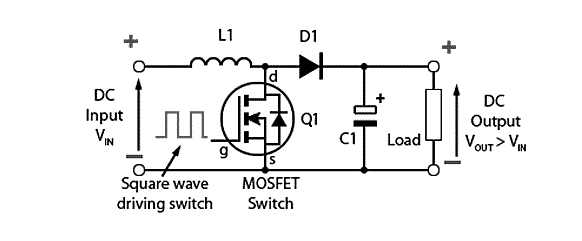A DC-to-DC converter is an electrical circuit or electromechanical device that converts direct current (DC) power into direct current power at a different voltage. Its power range can vary from very small like small batteries to very large (high-voltage power conversion). Some DC-DC converters have output voltages with the same reference point as the input voltage, while others have output voltages that are isolated from the input voltage. The table below simply shows the different types of dc dc converter, mainly consists of boost converter, buck converter, buck-boost converter and isolated dc dc converter.

The operational principle of the DC-to-DC converter is a straightforward one. The inductor in the input resistance has an unexpected variation in the input current. In the event of the switch being maintained in the high (on) position, the inductor functions in such a manner as to facilitate the transfer of energy from the input source, with the resultant energy being stored in the form of magnetic energy.
It is evident that if the switch is maintained in a low position (off), the energy will be discharged. In this instance, it is assumed that the output of the capacitor is sufficiently high to meet the time constant requirements of an RC circuit on the output side. The time constant is considered in relation to the switching period, with the objective being to ensure that steady-state conditions are maintained and a constant output voltage is achieved.

As power management chips become increasingly mature, semiconductor manufacturing processes continue to advance, and electronic design software becomes more intelligent, the functionality of portable devices continues to expand. The future development trends are as follows:
1. Increasing integration. Power management chips, particularly switching power supply chips, now integrate multiple circuit functions with other chips, simplifying peripheral circuit design and streamlining processes such as soldering and wiring. For multi-functional, multi-output DC/DC converters, internal circuits require additional work to enhance interference resistance.
2. High-load applications. From low-power portable devices to new charging equipment, the load current during converter operation is steadily increasing.
3. Programmable internal control systems. Traditional IC designs prioritise power delivery, which is insufficient for controlling system power efficiency. This requires circuits to accurately measure battery levels, determine operating modes based on input voltage variations, and disable unnecessary modules to optimally allocate power supply.
4. Multi-output functionality in switching power supplies is a key objective. Many appliances have varying power requirements and require multiple voltage levels. Switching power supplies with multi-output capabilities, independent switching, and excellent stability are increasingly becoming the mainstream in future power management chips.
5. Minimising costs. Portable devices have become essential products in daily life. Devices with the same functionality are becoming increasingly compact, and each consumer electronics device requires one or more DC/DC converters. Reducing the cost of each DC/DC converter while maintaining performance is a key objective.
6. The frequency range during DC/DC operation is expanding. In the overall circuit, PCB costs are primarily driven by board area and peripheral components. As operating frequencies increase, lower-cost inductors, capacitors, and transformers can be selected, thereby reducing output ripple, suppressing interference, and increasing the unit gain bandwidth to enhance interference resistance.
DC/DC converters play a crucial role in various electronic systems, providing stable voltage to ensure optimal performance and safety of underlying circuits. We introduce the types of DC converters, their working principles, and development trends, providing useful information for readers interested in this topic.








